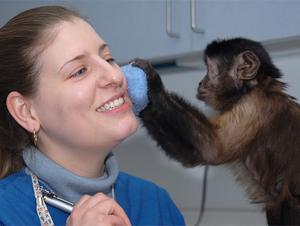Training monkeys to assist people with severe disabilities
Capuchin monkey trained to assist people with disabities. (Image from Helping Hands website, monkeyhelpers.org)
This story was originally covered by PRI’s Here and Now. For more, listen to the audio above.
When he was 22, Ned Rogers was in a car accident that left him with a brain injury and quadriplegia. Now 28, Ned is doing much better than his doctors ever expected, and he and his family believe this is partly due to the support of a five-pound monkey named Kasey.
Kasey came to Rogers from Helping Hands, a non-profit organization that trains capuchin monkeys to assist people with severe disabilities. Born at the Southwick Zoo in Mendon, Massachusetts, the monkeys are raised by foster families for their first five years, then brought to the Helping Hands training site. After the monkeys are trained to help with tasks like retrieving items from the refrigerator, changing CDs or pushing glasses back up the bridge of a person’s nose, they are placed in a home.
For Ned Rogers and his mother Ellen, Kasey was the perfect addition to their family. “She’s part of our family now, and as she get’s older, maybe she’ll retire; but the plan is that she would retire with us,” says Ellen. “You know, we will always want to have a Helping Hands monkey here.”
Besides getting the remote control for Ned or moving his water straw, Kasey has helped Ned in his recovery from the accident. Ellen explains, “His wanting to pet her, and wanting to have her have the walnuts or whatever — all of those things have helped his hand motion and his arm motion, and the occupational therapists believe that petting an animal or using your hands and your arms in a very natural way, is much better occupational therapy.”
Ned agrees. “[Look] how I’m raising my arm when that shouldn’t be the case.Doing little tasks every day is much better than driving to therapy twice a week,” he said.
The monkey was also essential in the Rogers family’s emotional recovery from the accident. Ellen explains that Kasey “brings so many smiles. What that does for us really lifts our spirits in ways that aren’t like getting a bottle out of the fridge.”
Ned describes the value of cuddling with Kasey: “See this is rad. Just, instead of watching TV, I’ll just lie here with her. And when I’m in pain … the pain goes away. She’s able to feel the negative tension and when there’s that negative tension she finds it her job to console me.”
Although Ned is living a different life than the one he planned, he is fulfilling dreams with the help of Kasey. Ned and Kasey have become educational speakers on the topic of spinal cord injuries. “This was a kid that always wanted to motivate and inspire others,” says Ellen. “He is doing exactly what he wanted to do.”
———————————————————————————
“Here and Now” is an essential midday news magazine for those who want the latest news and expanded conversation on today’s hot-button topics: public affairs, foreign policy, science and technology, the arts and more.More “Here and Now”.
